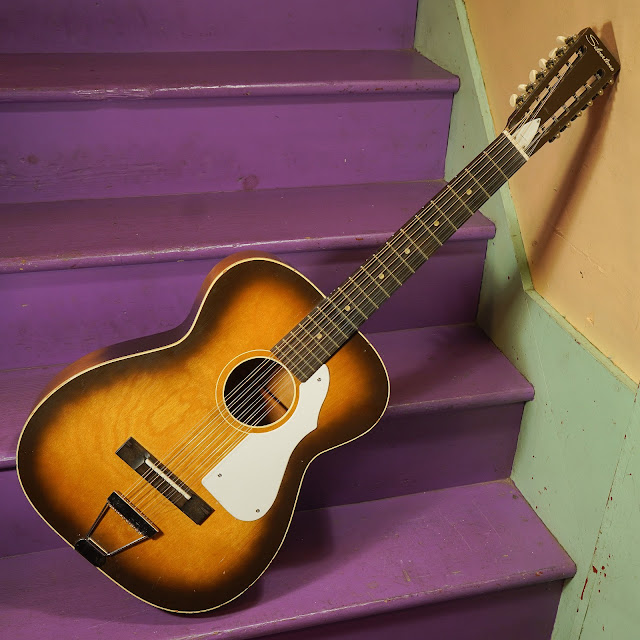1960s Silvertone (Harmony) H912 000-Size 12-String Guitar
Here's another big bruiser Harmony 12-string in Silvertone livery. I've worked on so many examples of this model under so many different names, but I think of it as the "Harmony Stella 12" because a lot of them bear the Stella name at the headstock and they're -- in a sense -- an echo of the Oscar Schmidt Stella 12-strings of the '20s and '30s in that they handle a bit like them and sound a lot like them, too.
These have solid birch bodies, are ladder-braced, and do that darker, thunky, woody, Leadbelly sound. I've got it strung-up for E-to-E tuning with lighter gauges, but it can certainly be strung with heavier stuff and tuned down. This one probably dates to the mid-late '60s because it has an adjustable truss rod installed -- the earlier models only had a non-adjustable rod.
Someone had attempted a bit of work on this in the past (a neck reset -- board was cut at the 12th fret, but the job did not yield a good angle) but I rectified that and now it's playing spot-on with low action and a fully-compensated (drop-in, for easy action-adjustment in the future) saddle. The nut width and neck profile are things you'll have to get used to (2" nut, flat board, bigger D profile) but once you get past that, you have access to a guitar that does that thing that you want from a Leadbelly-style box -- it has that plank, plunk, plank sound!
Repairs included: a neck reset, fret level/dress, new bone (compensated) saddle, new bone nut, cleaning, minor seam and brace repairs, setup.
Top wood: solid birch
Back & sides wood: solid birch
Bracing type: ladder
Bridge: ebonized mysterywood
Fretboard: ebonized mysterywood
Neck wood: poplar
Action height at 12th fret: hair-under 3/32” bass 1/16” treble (fast, spot-on)
String gauges: 46w-10
Neck shape: medium-big D
Board radius: flat
Truss rod: adjustable
Neck relief: straight
Fret style: medium-lower
Scale length: 25 1/8"
Nut width: 2"
Body width: 15 3/8"
Body depth: 3 7/8"
Weight: 4 lbs 8 oz
Condition notes: it's crack-free but the finish does show an average amount of wear and tear via light scratching, scuffs, nicks, and dings here and there throughout. I'm almost certain that the pickguard is replaced because its top texture is odd for an original one, but the shape and color is bang-on. The screws for the pickguard and truss rod cover are replaced. The truss rod cover has damage (split on one side) and was cut-down by a previous repairman. I can replace it if desired at no extra cost. The bone saddle and nut are new. The bridge saddle slot had been carved-up a little wonkily but I redrilled and cut it out so it would work like a normal "drop-in" guitar saddle slot. This means you can pull the saddle and shim it up if you desire higher action at any point.
















Comments